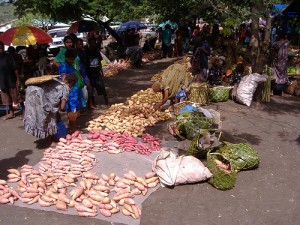Voice of America has five (count them!) articles and podcasts on the banana in Africa. Going to take me a while to get through the whole lot, but I’ll try to post a summary when I do.
Sweet potato diversity identified
Amazingly, there are people out there who can name a sweet potato variety at twenty paces. And in a photograph. Check out the comments to a recent flickr upload of mine showing a market in Rabaul. Now, if only I had geo-referenced it…

Michael plays Virgil
Bioversity’s Michael Mackay was recently interviewed on Radio Australia about plans to lead us all out of genebank database hell. Good luck to him!
Nibbles: Spices, Tequila, Tea, Potatoes, Archive, Africa, Carotenoids, Calcium, AGR, Ethiopia, Wheat blast
- Where do spices come from, mummy?
- Even “good” tequila can be bad for you. Well I never.
- Sparkling tea? Call it a microwine. Via.
- More potatoes. …
- … but the kicker is the historical archive she links to.
- AGRA and Earth Institute to collaborate. Africa not available for comment.
- More Pacific food crop nutrition goodness from Lois et al.
- Children may not like their veggies because of the Ca content.
- Canada down to 95% Holsteins. Oh dear.
- “The large crop genetic diversity that already exists in Ethiopia will make adapting agricultural systems to the locally changing conditions relatively easy.” Well, maybe…
- Screening Kansas wheat varieties for resistance to wheat blast.
Cacao goes sustainable, yes, but how?
The World Cocoa Foundation is offering a guide to the cocoa industry on sustainability principles that focus on equitable profit, labour standards and environmental issues.
That’s from a press release. There’s something similar on the World Cocoa Foundations’s blog. But I can’t find anywhere on the WCF website the teach-yourself-sustainable-cacao-farming document that I was foolishly expecting.
I guess we’ll have to make do with some general aims:
The sustainability initiative commits the foundation and its members to working toward three categories; profit, people and planet.
For the people category, the aim is for healthy and thriving cocoa-farming communities, where international labour standards are followed and farming practices are safe.
The planet category refers to responsible, sound environmental stewardship in cocoa-farming communities where soil and water are conserved and Integrated Pest Management to limit the use of agricultural chemicals, protecting the fragile tropical ecosystem.
And in terms of profit, the aim is to improve equitable economic returns for farmers built upon expanding entrepreneurial skills, stronger and more effective farmer associations, and more productive, profitable farming practices.
and a bunch of example projects. Not much about the importance of genetic diversity, alas.